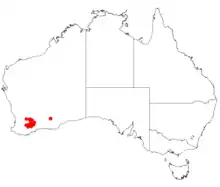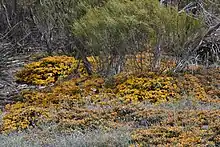| Acacia acanthaster | |
|---|---|
 | |
| Scientific classification | |
| Kingdom: | Plantae |
| Clade: | Tracheophytes |
| Clade: | Angiosperms |
| Clade: | Eudicots |
| Clade: | Rosids |
| Order: | Fabales |
| Family: | Fabaceae |
| Subfamily: | Caesalpinioideae |
| Clade: | Mimosoid clade |
| Genus: | Acacia |
| Species: | A. acanthaster |
| Binomial name | |
| Acacia acanthaster | |
 | |
| Occurrence data from AVH | |
| Synonyms[1] | |
|
Racosperma acanthaster (Maslin) Pedley | |

Acacia acanthaster is a species of flowering plant in the family Fabaceae and is endemic to the south-west of Western Australia. It is a rigid, densely-branched, domed shrub with flat, linear phyllodes, spherical heads of golden-yellow flowers, and curved pods that resemble a string of beads.
Description
Acacia acanthaster is a rigid, densely-branched, domed shrub that typically grows to 0.2–0.5 m (7.9 in – 1 ft 7.7 in) high and 1–2.5 mm (0.039–0.098 in) wide. Its branchlets are glabrous, and divided near the ends into a few short, radiating, leafless spines. The phyllodes are glabrous, flat and linear, 3–8 mm (0.12–0.31 in) long and 0.5–1 mm (0.020–0.039 in) wide. Between 18 and 27 golden-yellow flowers are arranged in 1 or 2 spherical heads 3.0–3.5 mm (0.12–0.14 in) long on a peduncle 6–11 mm (0.24–0.43 in) long. Flowering occurs from August to October and the pods are curved or loosely coiled, 35 mm (1.4 in) long, 1.5–2.5 mm (0.059–0.098 in) wide and resemble a string of beads. The seeds are elliptic, about 2 mm (0.079 in) long and have a white, club-shaped aril.[2][3][4][5]
Taxonomy
Acacia acanthaster was first formally described by the botanist Bruce Maslin in 1999 in the journal Nuytsia from specimens collected about 63 km (39 mi) north-east of Norseman from specimens collected by Kenneth Newbey in 1980.[6][5] In 2006, Leslie Pedley transferred the species to Racosperma as R. acanthaster, but that name is considered a synonym of A. acanthaster by the Australian Plant Census.[1] The specific epithet (acanthaster) means "a prickly star", referring to the spines on the ends of the branchlets.[7]
Distribution and habitat
This shrub grows in sandy soil, clay or loam on granite outcrop, hills and plains in disjunct places between Dumbleyung, Lake King and Narembeen, and near the type location, near Sinclair Soak, in the Avon Wheatbelt, Coolgardie and Mallee bioregions in the south-west of Western Australia.[2][3][4]
See also
References
- 1 2 3 "Acacia acanthaster". Australian Plant Census. Retrieved 12 December 2022.
- 1 2 "Acacia acanthaster Maslin, Nuytsia 12: 312 (1999)". World Wide Wattle. Department of Parks and Wildlife. Retrieved 9 March 2018.
- 1 2 "Acacia acanthaster". FloraBase. Western Australian Government Department of Biodiversity, Conservation and Attractions.
- 1 2 Maslin, Bruce R. Kodela, Phillip G. (ed.). "Acacia acanthaster". Flora of Australia. Australian Biological Resources Study, Department of Climate Change, Energy, the Environment and Water: Canberra. Retrieved 14 December 2023.
- 1 2 Maslin, Bruce R. (1999). "Acacia miscellany 16. The taxonomy of fifty-five species of Acacia, primarily Western Australian, in section Phyllodineae (Leguminosae: Mimosoideae)". Nuytsia. 12 (3): 312–313. Retrieved 14 December 2023.
- ↑ "Acacia acanthaster". APNI. Retrieved 2 December 2023.
- ↑ Sharr, Francis Aubi; George, Alex (2019). Western Australian Plant Names and Their Meanings (3rd ed.). Kardinya, WA: Four Gables Press. p. 125. ISBN 9780958034180.